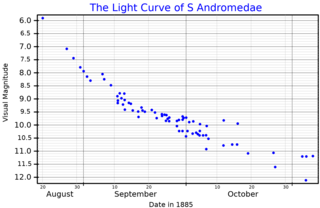
SN 1885A was a supernova in the Andromeda Galaxy, the only one seen in that galaxy so far by astronomers. It was the first supernova ever seen outside the Milky Way, though it was not appreciated at the time how far away it was. It is also known as "Supernova 1885".
The SuperNova Early Warning System (SNEWS) is a network of neutrino detectors designed to give early warning to astronomers in the event of a supernova in the Milky Way, our home galaxy, or in a nearby galaxy such as the Large Magellanic Cloud or the Canis Major Dwarf Galaxy.
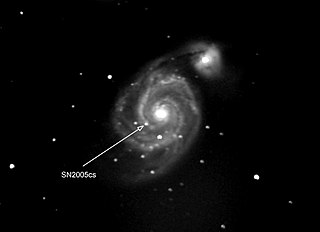
SN 2005cs was a supernova in the spiral galaxy M51, known as the Whirlpool Galaxy. It was a type II-P core-collapse supernova, discovered June 28, 2005 by Wolfgang Kloehr, a German amateur astronomer. The event was positioned at an offset of 15″ west and 78″ south of the galactic nucleus of M51. Based on the data, the explosion was inferred to occur 2.8 days before discovery. It was considered under-luminous for a supernova of its type, releasing an estimated 3×1050 erg in energy.
Robert Owen Evans, OAM was an Australian minister of the Uniting Church in Hazelbrook, New South Wales, and an amateur astronomer who holds the record for visual discoveries of supernovae (42).
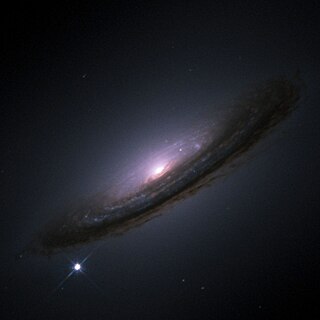
SN 1994D was a Type Ia supernova event in the outskirts of galaxy NGC 4526. It was offset by 9.0″ west and 7.8″ south of the galaxy center and positioned near a prominent dust lane. It was caused by the explosion of a white dwarf star composed of carbon and oxygen. This event was discovered on March 7, 1994 by R. R. Treffers and associates using the automated 30-inch telescope at Leuschner Observatory. It reached peak visual brightness two weeks later on March 22. Modelling of the light curve indicates the explosion would have been visible around March 3-4. A possible detection of helium in the spectrum was made by W. P. S. Meikle and associates in 1996. A mass of 0.014 to 0.03 M☉ in helium would be needed to produce this feature.

SN 2006X was a Type Ia supernova about 65 million light-years away in Messier 100, a spiral galaxy in the constellation Coma Berenices. The supernova was independently discovered in early February 2006 by Shoji Suzuki of Japan and Marco Migliardi of Italy.

SN 2003fg, nicknamed the Champagne Supernova, was an unusual Type Ia supernova. It was discovered in 2003, with the Canada-France-Hawaii Telescope and the Keck Telescope, both on Mauna Kea in Hawaii, and announced by researchers at the University of Toronto. The supernova occurred in a galaxy some 4 billion light-years from Earth. It was nicknamed after the 1995 song "Champagne Supernova" by English rock band Oasis.

The known history of supernova observation goes back to 1006 AD. All earlier proposals for supernova observations are speculations with many alternatives.

Nicholas B. Suntzeff is an American astronomer and cosmologist. He is a university distinguished professor and holds the Mitchell/Heep/Munnerlyn Chair of Observational Astronomy in the Department of Physics & Astronomy at Texas A&M University where he is director of the Astronomy Program. He is an observational astronomer specializing in cosmology, supernovae, stellar populations, and astronomical instrumentation. With Brian Schmidt he founded the High-z Supernova Search Team, which was honored with the Nobel Prize in Physics in 2011 to Schmidt and Adam Riess.
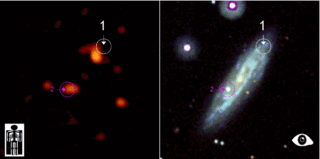
SN 2008D is a supernova detected with NASA's Swift X-ray telescope. The explosion of the supernova precursor star, in the spiral galaxy NGC 2770 (88 million light years away, was detected on January 9, 2008, by Carnegie-Princeton fellows Alicia Soderberg and Edo Berger, and Albert Kong and Tom Maccarone independently using Swift. They alerted eight other orbiting and ground-based observatories to record the event. This was the first time that astronomers have ever observed a supernova as it occurred.
SN 2005gj was a supernova located approximately 864 million light years away from Earth. It was discovered on September 27, 2005, by the Sloan Digital Sky Survey and the Nearby Supernova Factory. 2005gj was noted because it had qualities of both type Ia and type IIn supernovae, and because hydrogen emission lines were found in its spectrum. These hydrogen lines, which were found on the spectrum at redshift z=0.0613, are thought to be indicative of interactions with a circumstellar medium by the supernova's ejected matter or white dwarf progenitor. Such emission lines are extremely rare in Type Ia supernovae – only one other Type Ia, SN 2002ic, has been observed to exhibit the same properties. However, 2005gj's CSM interaction was much stronger and more clearly observed than 2002ic's. The mass-loss history 2005gj's hydrogen lines suggest has been cited as evidence that luminous blue variable (LBV) hypergiants can be progenitors of thermonuclear supernovae.
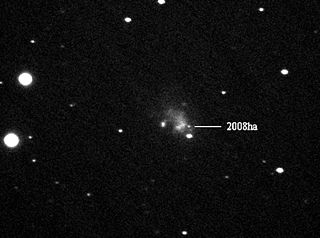
SN 2008ha was a type Ia supernova which was first observed around November 7, 2008 in the galaxy UGC 12682, which lies in the constellation Pegasus at a distance of about 21.3 megaparsecs (69 Mly) from Earth.
SN 2005E was a calcium-rich supernova first observed in January 2005 that scientists concluded was a new type of cosmic explosion. The explosion originated in the galaxy NGC 1032, approximately 100 million light years away.
SN 2010lt is a supernova located in the galaxy UGC 3378 in Camelopardalis. It was discovered by amateur astronomers Kathryn Aurora Gray, her father Paul Gray, of Fredericton, New Brunswick, Canada and David J. Lane of Stillwater Lake, Nova Scotia, Canada. Upon discovery, Kathryn Aurora Gray became the youngest person to ever discover a supernova, being 10 years old when she did so. The previous record was held by the 14-year-old Caroline Moore.
SN 2011dh was a supernova in the Whirlpool Galaxy (M51). It was discovered on 31 May 2011, with an apparent magnitude 13.5. and confirmed by several sources, including the Palomar Transient Factory. A candidate progenitor was detected in Hubble Space Telescope images. The progenitor may have been a highly luminous yellow supergiant with an initial mass of 18-24 solar masses. The supernova peaked near apparent magnitude 12.1 on 19 June 2011. Emission spectra indicated that the explosion was a type II supernova, in which a massive star collapses once nuclear fusion has ceased in its core.
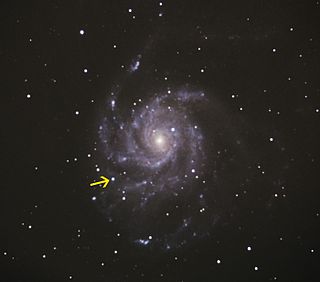
SN 2011fe, initially designated PTF 11kly, was a Type Ia supernova discovered by the Palomar Transient Factory (PTF) survey on 24 August 2011 during an automated review of images of the Messier 101 from the nights of 22 and 23 August 2011. It was located in Messier 101, the Pinwheel Galaxy, 21 million light years from Earth. It was observed by the PTF survey very near the beginning of its supernova event, when it was approximately 1 million times too dim to be visible to the naked eye. It is the youngest type Ia ever discovered. About 13 September 2011, it reached its maximum brightness of apparent magnitude +9.9 which equals an absolute magnitude of about -19, equal to 2.5 billion Suns. At +10 apparent magnitude around 5 September, SN 2011fe was visible in small telescopes. As of 30 September the supernova was at +11 apparent magnitude in the early evening sky after sunset above the northwest horizon. It had dropped to +13.7 as of 26 November 2011.

SN 1895B was a supernova event in the irregular dwarf galaxy NGC 5253, positioned 16″ east and 23″ north of the galactic center. It is among the closest known extragalactic supernova events. The supernova was discovered by Williamina Fleming on December 12, 1895 after noticing an unusual spectrum on a photographic plate taken July 18, 1895, and was initially given the variable star designation Z Centauri. The light curve is consistent with an event that began ~15 days before the discovery plate was taken, and this indicates the supernova reached a peak visual magnitude of up to 8.49±0.03.
SN 1940B was a supernova discovered on 5 May 1940 in the galaxy NGC 4725 in Coma Berenices. It had a magnitude of 12.8 and became the first observed type II supernova.










